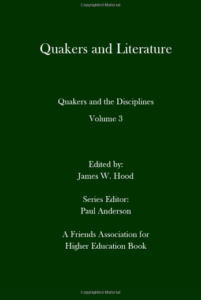Quakers and Literature (Quakers and the Disciplines Volume 3)
Reviewed by Michael S. Glaser
November 1, 2016
 Edited by James W. Hood. Friends Association for Higher Education, 2016. 167 pages. $19.95/paperback.
Edited by James W. Hood. Friends Association for Higher Education, 2016. 167 pages. $19.95/paperback.
Buy from QuakerBooks
The central thread that holds together the essays in Quakers and Literature is the invitation to “ponder the complex nexus of Quakerism and imaginative literature.” Some of the essays address what is perhaps an even larger and more important question: Is there a compelling voice to the Quaker experience that is vital to today’s world? Or is the Religious Society of Friends quagmired in its past writers, whose voices are experiencing a diminishing vitality and are increasingly normalized within a white, middle-class culture?
The first three essays are rather scholarly explications from a Friendly perspective of works by such writers as John Woolman, Mary Neale, and Susanna Morris. Of particular interest to those who specialize in early twentieth-century British and/or American literature will be the inclusion of members of Virginia Woolf’s Outsiders’ Society. Each of these essays helps establish what might be the unstated theme of the book’s first part: that there was a certain bravery among early Quaker writers in the face of a Society that regularly denounced imaginative literature and the arts as morally depraved. Jon R. Kershner’s essay on John Woolman seeks to extrapolate the fullness of Woolman’s prophetic voice and its importance to the lives of people in the twenty-first century, and Helene Pollock’s “Learning from Mary Neale” compares Neale’s life to Woolman’s in order to offer “a clearer picture of Neale’s particular way of looking at God’s power.” Maura L. Hoopes’s “The Power of Story in Susanna Morris’s Journal” offers a fascinating summary of Morris’s life while suggesting how, in that story, we might gain glimpses into our own story.
I was most excited by Diane Reynolds’s essay in part 4, which asked “Quaker Literature: Is There Such a Thing?,” because of the forthrightness of her observation that too much Quaker literature hides “behind a backward-looking hedge.” She suggests a need for literature that confronts “the real issues contemporary Quakers face: our own struggles with and capitulations to the military industrial complex and global power structures that use our money and resources to fund projects . . . antithetical to our Quaker witness.”
As one whose passion is the teaching of literature, I found this collection to come most alive during the last three essays, which focus on the practice of writing and teaching of literature from a Quaker perspective. William Jolliff’s address on the practice of writing poses significant questions such as “What is the role of the Quaker poet in community?” and “How does the Quaker poet find a way to contribute to, to minister in, that high art community?” Jolliff addresses those questions with a candid defense of literature as well as practical suggestions for writers, concluding that Quaker poets have essential work to do.
Darlene Graves’s essay on the use of theatre in a Quaker pedagogy is perhaps most fascinating in its documentation of three centuries of Quaker belief that theatre was at best frivolous and most likely immoral, fostering “lust, vanity, and wantonness.” Graves shares details of her own journey to create and use theatre as a means of bringing light into the darkness while closely reflecting Quaker principles of community.
Quakers and Literature concludes with Mike Heller’s discussion of teaching spiritual autobiography. Heller sees this as a means of creating opportunities for literature professors to create meaningful, reflective experiences for students. Such experiences engage them in living a more deeply examined life, seeing their world with more compassionate eyes, and, in short, letting their lives speak.
In conclusion, I can’t help but think of how the writing of Parker Palmer might serve as a perfect example not only of letting one’s life speak, but also of how such work can provide an ideal model of how Quaker writers today might create a vitality and dynamism that seem to have been mostly missing from twentieth- and twenty-first-century Quaker writing.



Comments on Friendsjournal.org may be used in the Forum of the print magazine and may be edited for length and clarity.